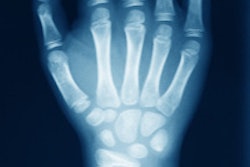How well do junior physicians working in emergency departments interpret the exams they order for their patients when a radiologist is unavailable? Not as confidently and accurately as they should, according to an article in press published 25 July in Radiography.
A study measuring the accuracy of junior doctors working in an Irish university teaching hospital to determine how well they identified wrist fractures and intracranial bleeding from x-ray and CT scan images revealed that on average they missed a lot of diagnoses. When reviewing the same images, senior radiographers outperformed the doctors.
When radiologists are not immediately available to interpret imaging exams, an emergency physician is expected to do this and to make the diagnosis. But is a first year junior doctor experienced enough? And even though the responsibility of diagnosis is that of the physician, could a radiographer's opinion help? Researchers at University College Dublin and the Adelaide and Meath Hospital in Dublin decided to find out.
Lead author Dr. B.S. Kelly, from the diagnostic imaging department at the university's School of Medicine and Medical Science, and colleagues obtained 40 head CT images and 42 wrist radiographs, 30 of which were analog film images. Twenty-one wrist x-rays had distal radius fractures, seven of which were incurred by pediatric patients. Twenty head CT images showed fresh intracranial bleeding.
All images were displayed in digital format on a high-quality LCD monitor in consistent, optimum lighting conditions. Images could be window width and leveled, panned, and zoomed.
The study's objective was to determine if the diagnostic accuracy of junior doctors and radiographers could be improved by working together. Five junior doctors and five senior radiographers were recruited to individually interpret the images and annotate the ones with positive findings.
Immediately upon completion, a radiographer was randomly assigned a junior doctor partner, and they were asked to work together to interpret the images. They were also asked to record their level of confidence of the presence or absence of fractures and intracranial bleeding, first when working independently and then collaboratively. At no time were they allowed access to clinical records of the patients.
Radiographers outperformed the junior doctors in both categories, with the junior doctors achieving the lowest confidence level score 95% of the time. However, the performance of the junior emergency physicians improved significantly when they worked collaboratively with the radiographers.
When working with a radiographer, the doctors identified an average of 17.2 wrist fractures out of a total of 21, compared to 13.9 fractures when working alone. Similarly, they identified an average 12.8 out of 20 cases of intracranial bleeding working together, and slightly fewer, 11.8 cases, working alone.
"What was interesting was that in nine of 10 cases, there was evidence of synergy between the pairs," the authors wrote. "If both professions gave a possible distal fracture a confidence rating of two or three, then in collaboration they were more likely to give a rating of six or seven to the same lesion."
When queried, all of the physicians stated the experienced radiographers' assistance had positively affected their ability to accurately interpret images. Most of the radiographers liked helping out as well.
While the study had obvious limitations in terms of number of participants, types of images, and number of cases reviewed, the research suggested that collaboration between senior radiographers and junior doctors can improve the accuracy of diagnostic decisions. The authors recommended that additional and greatly expanded research should be conducted.
They also recommended that junior doctors receive additional training in the interpretation of diagnostic images, particularly those they might frequently see in an emergency department.
"The significant improvement in diagnostic performance of the junior doctors following collaboration would strongly suggest that changed practices should be introduced to facilitate improved patient care," they wrote. "Collaboration ... exceeds the sum of the parts."
Such collaboration could help reduce the chances of overlooked findings, which could alter patient management, when a radiologist is not immediately available to interpret images.



















